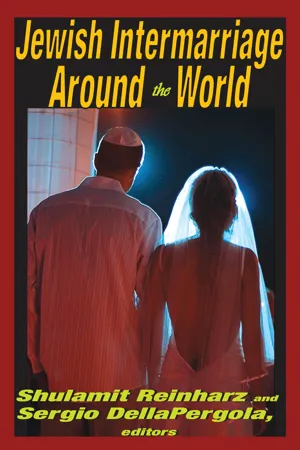![]()
British Jewry and Its Attitudes towards Intermarriage
Marlena Schmool
Introduction
The present-day British Jewish community traces its origins to 1656 when, after representations to Lord Protector Oliver Cromwell by Rabbi Menasseh ben Israel, Jews were allowed to worship openly in England. Thus, in European Jewish terms, modern British Jewry is relatively young. This reestablishment, following an absence of over 360 years, was never formalized by any law that recognized the Jews as a community. To this day, the British Jewry has no special obligations in respect of the host society and no benefits, such as the proceeds of local religious taxes. Jews, as individuals and as a community, have gained rights along with—and sometimes in the wake of—other religious minorities such as non-conformists and Roman Catholics. The community did not directly suffer population loss from the Holocaust, although the blitz accelerated the decline of the area of first settlement in London’s East End and ultimately, Britain received many post-war Jewish immigrants. In the century since the mass immigration from East and Central Europe, the Jewish community, which is now 83 percent British-born, has become well-integrated into the open, British society.
In spite of the lack of separation of church and state, Britain is a secular country. The British Social Attitudes survey distributed in 2000 found that, of the 3,426 adults living in private households sampled, 39.5 percent said they had “no religion.”1 Researchers Johnston and Jowell noted that this proportion has grown dramatically from 31 percent in 1983.2
By contrast, the voluntary3 religion question on the 2001 census of England and Wales found only 16 percent with “no religion.” On the census, 71.2 percent noted that they are Christian, and 5 percent belonged to minority religions; 3 percent were Muslim, Hindus 1 percent and Jews are one-half of 1 percent. The censuses of England, Wales, and Scotland together showed 266,375 people self-identifying as Jews in reply to that voluntary question. This Jewish population is approximately the size of that of Greater Chicago but is spread throughout an entire country.
In spite of its lack of constitutional legal standing, the British Jewish community receives funding for services such as education and welfare. For the former, thirty-nine Jewish day schools receive local authority support for the National Curriculum (secular) studies they provide but the parents pay for Jewish studies.4 For the latter, Jewish homes and other services are financed partly through local government where an individual’s funding entitlement is channelled through the Jewish agencies. There are more than 100 Jewish welfare organizations nationally5 most of which are based in the Greater London area.
By the standards of many communities, British Jewry is highly centralized and has a socio-religious structure that somewhat mirrors the national one. The leading elected representative organization is the Board of Deputies of British Jews, founded in 1760, which interfaces with central government on behalf of the community. It currently has 271 deputies who are elected by synagogues and organizations from all areas. The right-wing orthodox synagogues do not seek membership on the Board but their viewpoint is voiced through deputies who may represent more mainstream institutions. The Board as “the voice of the Jewish community” consults, coordinates and cooperates to present the community’s stance on matters ranging from faith schools, to shechita (ritual animal slaughter), Israel, anti-Semitism, and welfare provision. Lately, the government has made clear that it wishes to have one central contact point for each faith community and the Board is that point for British Jewry.
The United Synagogue, as the single largest synagogal organization, is sometimes regarded as the Jewish parallel to the Church of England and constitutes a second element in the traditional British Jewish establishment. Jewish Care as the major welfare provider and the United Jewish Israel Appeal (UJIA) as the main fundraising body complete this group of institutions. British Jewry does not have coordinated fundraising or a community chest although the idea has been discussed from time to time and was tried, but not very profitably, in one medium-sized regional community.
The synagogue is the main membership institution in the community: there are 356 congregations in Britain. These range in size from the large, central London cathedral-like synagogues, which draw their membership from across and outside the metropolis to shteibls with a small, regular local minyan. Surveys have shown that some 70 percent of British Jewry is in some way linked to a synagogue.6 This proportion has been constant for some forty years and in part owes its consistency to the way in which Jewish burials are organized in Britain. The majority of synagogues have a burial society, and synagogue fees contain an element for funeral expenses, which most people pay. These funeral expenses are for the most part not transferable between synagogues with the result that, having once joined a particular synagogue and paid funeral fees, it is difficult to move to another synagogue without possible financial loss. This rule has been a force for conservatism within British synagogue life.
The United Synagogue has 64 constituent and affiliated congregations, mainly in the Greater London area. The United Synagogue was established by Act of Parliament in 1870 and, strictly speaking, the Chief Rabbi is head of these synagogues. There are regional orthodox congregations throughout Britain and the Commonwealth that recognize his authority and leadership but there are also, even within the mainstream orthodox sector in London, synagogues that do not. Beyond those, there are the haredi communities on one side and the progressive sector on the other, made up of the Masorti, Re...
